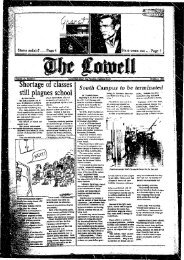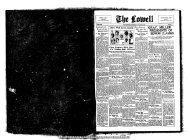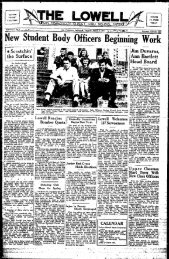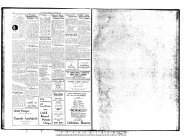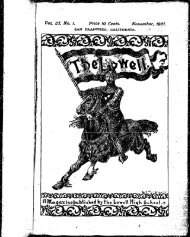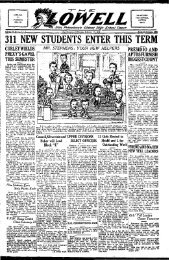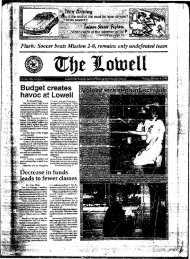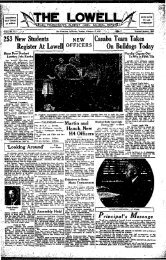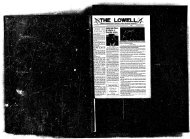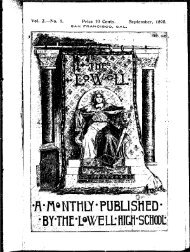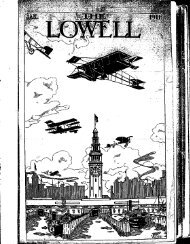Severely handicapped class arrives - The Lowell
Severely handicapped class arrives - The Lowell
Severely handicapped class arrives - The Lowell
You also want an ePaper? Increase the reach of your titles
YUMPU automatically turns print PDFs into web optimized ePapers that Google loves.
ft** 14. <strong>The</strong> loxtU. Aartl II. IKS<br />
PROFILES.<br />
Movie soundtracks<br />
making noise<br />
By Jonathan Alberts<br />
In retrospect, the results or the last few Arafcmy<br />
Awards ceremonies seem to indicate that the Bay<br />
Am possess* • thriving movie soundtrack industry.<br />
In fact, over the put several years. Bay Areaproduced<br />
soundtracks have dominated Uie nominations<br />
for the Sound Oscar.<br />
Amadcus, which won eight Academy Awards<br />
ovcnll. including one for sound, is an example of the<br />
special work being done in the Bay Area<br />
<strong>The</strong> film, including the soundtrack, was produced<br />
a! the Saul Zaentz Film Center in Berkeley. <strong>The</strong><br />
sovadtnek's production was supervised by Bay Area<br />
sound designers Mark Berger. Tom Scott, end Todd<br />
:Roekelbeide.<br />
Many more film soundtracks with Bay Area<br />
backgrounds have achieved fame and recognition.<br />
Tte Right Satf. for example, was last year's winner<br />
of the O«car for Sound. This movie's soundtrack,<br />
like that of Amadou, was produced at the Saul Zacntz<br />
Film Center.<br />
Never Cry Wotfil anothct movie whose soundtrack<br />
was produced at this facility.<br />
• <strong>The</strong> nuking of a movie soundtrack is often times a<br />
tedious process. When a movie viewer sees a scene<br />
where many different actions are taking place und<br />
many different sounds are being generated and blended<br />
together, he may be under the impression that the<br />
sounds were simply recorded on the spot, h cannof be<br />
done that way.<br />
In this age of stereophonic sound, viewers demand<br />
sound clarity and realism beyond what might actually<br />
be heard in the "true" siluiuon. Film producers cannot<br />
just record sound as they film.<br />
<strong>The</strong> modem process of sound editing and producing<br />
doesn't only involve the music to be played during<br />
the movie. Of equal importance to the producers<br />
are the less obvious, sometimes almost undctcctable.<br />
sounds which increase realism or help create and control<br />
the mood of a movie.<br />
All sounds arc recorded individually and then spliced<br />
into • reel at the appropriate moment of the movie.<br />
One reel, for example, might contain all of the car<br />
engine sounds for a movie. This reel would eventually<br />
be played simultaneously with the cube: sound<br />
reels for this movie to create a master rcct containing<br />
all of the sound effects at precisely the right moment.<br />
This time-consuming work requires patience and<br />
skill. In producing Amadeus. over 70 reels of sound<br />
effects were recorded for the market scenes alone.<br />
Overall, the soundtrack for this movie required a<br />
year's work on the part of Bergcr. Scott, and<br />
Boekelheidc.<br />
Besides the Saul Zacntz Film Center in Berkeley.<br />
Lucasfilm is located in Sui Rafael and in San Francisco<br />
there is Francis Ford Coppola's Zoctrope<br />
Studios.<br />
A publicity spokesperson for Uicaifilm commented.<br />
"I don't know why wr'rc all up here. It's<br />
just coincidence."<br />
Making money in SF<br />
By Jculca Leung<br />
Ot* a Monday morning in 1848, a nun named John<br />
Marshall flood ankle-deep ai the south forte of the<br />
American River in Cilifomia and found pieces of a<br />
yellow metal. <strong>The</strong> metal tuned out to be gold, and<br />
thus began what historians consider "the greatest<br />
adventure since the Crusades'* — the Gold Rush of<br />
1849.<br />
At (he onset, the gold seekers, or Forty-Niners as<br />
they soon became known, were relatively few in<br />
- number. In a few short years, however, the count<br />
nearly doubled from 140.000 to a fourth of a million.<br />
Men from all pans of the world with varying cultures<br />
Cocked to this former Mexican province, bringing<br />
with them universal ambitions and desires.<br />
Meanwhile, the coinage situation in tic Weil was<br />
one of chaotic heterogeneity. Many different kinds<br />
circulated, among them French louisdors, Dutch<br />
guilders. Indian rupees. Mexican reals, English shtllings,<br />
and American prcccs. For commerce to grow, a<br />
standardized form of currency was needed.<br />
Nature, hu^.'ver, did not design raw gold for the<br />
needs of commerce. To meet monetary requirements,<br />
the gold must be fashiored into standard forms of<br />
standard value and convenient size. In other words, it<br />
had to be minted into coins.<br />
In his final message to Congress in 1948. President<br />
James K. Polk first proposed the building of a brsnt h<br />
mint in California. On *uly 3. 1852. Congresi<br />
authorized the establishment of a US mint in San<br />
Francisco.<br />
<strong>The</strong> first mint, the predecessor ot wSat U now<br />
known as the Old Mint, was located in a gO-'oot<br />
square buHdins on Comiaercial Street. <strong>The</strong> gold<br />
coins produced the first year valued $4 million.<br />
Merely two yean later, product totaled $25<br />
million,<br />
.As time went by. the relatively small mint could no<br />
longer meet the growing demands. Thus, in 1874.<br />
. operations moved to new quarters at Fifth and MUaiott<br />
streets, a contemporary, nxrny factory often<br />
called "one of the best appointed mints in the<br />
-;; world."<br />
To CaJifomlans who were separated from "the<br />
• finer things" bade East, the mint, a fine example of<br />
the architectural style known as Federal Cubical<br />
Revival, was more than a coin-producing facory; it<br />
was a laark or culture and progress. Its spacious<br />
steps, backed by a sextet of Doric columns, became<br />
• everyone's favorite spot for politics] and industrial<br />
Not iy did the mint pov\cv» jcsthctk; beauty, hut<br />
endurt.-ri strength as well. <strong>The</strong> San Francisco Cult<br />
wrote of the building, "<strong>The</strong> fire department will have<br />
little trouble quenching an> conflagration that may<br />
arise within its walls, and unless an earthquake gives<br />
it a subterranean quietus, it bids fair lo stand for<br />
centuries."<br />
This prediction proved to be true in (he Earthquake<br />
of 1906. Of all the buildings in what was the business<br />
district, the mint was the only one to emerge unscathed.<br />
During the di*a»tcr. loyal employees risked their<br />
lives and came to rescue the mint. Engulfed by domes<br />
and melting glxu, they pumped water from the artesian<br />
well below the central court to save the building<br />
from subsequent fire.<br />
Through the 1906 Calamity and three major wars<br />
the Old Mint served. Ironically, it could not meet the<br />
increasing demand of the changing times for coins.<br />
To increase production, operations were moved once<br />
again in 1937 — this time lo a square, marble edifice<br />
overlooking the city at Duboce and Bucharun streets.<br />
$$$$$$$$$$$$$$$<br />
On June 16, 1973, the Old Mint wns officially<br />
opened to the public as a museum. <strong>The</strong> front of the<br />
building serves as the museum, while the rear houses<br />
the mint's rpecial coins and medals division. <strong>The</strong><br />
computer center within the mint permits the mint to<br />
rapidly process orders for. the public. This service<br />
generates millions of dollars a year, thus making<br />
u^toration possible without tax fiinds.<br />
K*tt the shop where souvenir ure sold and coins<br />
a.t orc-anl by collectors, the public can see •otnc of<br />
the scaltA used to weigh gold during the days of the<br />
Cold Rui n. Some of them are Will sensitive enough to<br />
detect m; weight of a pencil mark on a pit. e of paper.<br />
At' -OM of one dollar, the visitor can press a but*<br />
ton on a massive 1869 press and thus create his own<br />
medal bearing the design of the mint building on its<br />
• *ce, and an outline map of the United States<br />
superimposed on an eagle with outstretched *ings on<br />
the reverse side.<br />
In addition, the visitor can see 4 stack of .999 pure<br />
gold ban. which weighs over a ton and costs more<br />
thanSt million.<br />
<strong>The</strong>se are but some of the many attractions at the<br />
Old Mint* which is opea to the public on weeedxys<br />
from 10 a.m. to 4 p.m. School tour* arc welcome.<br />
For further information, call 974-0788.<br />
business.<br />
Anchor Steam Beer<br />
Overflowing^<br />
with taste<br />
By Robert Kim<br />
In an age when most breweries<br />
aSt? 3*e of the art equipment, and<br />
wxne nw artificial ingredients. Anchor<br />
Brew\-ry Company adheres to a<br />
novel approach in nuking Anchor<br />
Stcim Beer: tradition and<br />
authenticity.<br />
"We're nuking a distinctive beer.<br />
one with integrity and quality," says<br />
nwncr and head brewmaster Friu.<br />
Maytag. "I believe a brewer thouk!<br />
know atom tradition. He thould hrrl<br />
the ambition to maintain inter'jy."<br />
Upon entering ihe brewery, one<br />
can seme tradition. <strong>The</strong> reception<br />
room or "'taproom" looks like a<br />
muKum. Noitalgic beer tigns and<br />
Urge repticu of old bottle capt hang<br />
from the wallv A di«pliy catc cxhibiti<br />
antique brewing tool*.<br />
However, thi* union i* quickly<br />
•titpellnl when one pcen through the -<br />
huge panoramic windows of the<br />
upruom. <strong>The</strong>y rewal three Urge copper<br />
vnscls Uut are actually nuking<br />
One can see workers supervising<br />
and regulating tlic gleaming vessels.<br />
Ma) tag imported these vends from<br />
Germany because they were traditional<br />
brewing veuclt. This process<br />
allows Anchor lo produce an authentic<br />
styled beer uniquely dark,<br />
dense, and slightly bitter.<br />
"I struggled to do everything in the<br />
brewery as traditionally as possible,"<br />
uys Maytag.<br />
Anchor is a "large<br />
microbrewcry." a tiny drop in -Jie<br />
barrel compsred.lo Anheuser Busch<br />
and Miller, the industry leaders.<br />
Because Anchor is relatively small.<br />
il allows for a tcamlikc atmosphere<br />
among the employees. Maytaj siys<br />
that he nirts Anchor like a family,<br />
with free di'xusuon and shared<br />
respor-jbiliry.<br />
"All the employees here feel that<br />
they've got the whole company on<br />
their ihoulders." explains general<br />
manager Gordon MacDermotl.<br />
Ttutt's the reason for our quality.'*<br />
Also. "Anchor makes the product<br />
for itself, not sacrificing quality for<br />
gantity," says co-worker Bailey<br />
While most modem breweries rely<br />
oo artificial prescrvKrves to stop<br />
""oobscterial growuX Anchor uses<br />
only hops, a natural preservative.<br />
Anchor relies oo a bmnflg process<br />
thai combines oid-world quality and<br />
state of the an technical knowledge<br />
to produce its distinctive brew.<br />
Anchor Steam Beer is made differently<br />
than the major bonds.<br />
While the common lager been are<br />
brewed by slow fermentatfad and<br />
alorcd In refrigerator cdhfi for '<br />
maturing, steam beers are brewed at<br />
higher fermentation tetspentores.<br />
<strong>The</strong>y were popuUrucd in 19tb century<br />
mining camps which lacked<br />
refrigeration facilities.<br />
Produced in San Francnco since<br />
1896. Anchor Steam Beer was not the<br />
only steam beer around. In fact, there<br />
were .'.cvcral hundred •steam<br />
breweries, even before the Anchor<br />
Brewing Company (then called<br />
Golden City Brewery) exatai.<br />
In 196$. Mayug (whost great<br />
gnadfathaTT fouiuM ibr«M




